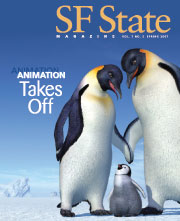 |  | |||
 Global Warning Professor Jonathon Stillman has a window on a warmer future. Hundreds of small crabs are providing the view. Inside the University's Romberg Tiburon Center for Environmental Studies, Stillman is uncovering clues about climate change by studying the porcelain crab. By testing its physiological responses to varying air and water temperatures, he has shown that some species can adjust to these changes more than others. "For some animals high on shore, their heat tolerance is right at their limit so small changes would impact them. If the temperature rises 2 degrees Celsius, they won't be able to survive," Stillman says. Warmer temperatures would force these species to migrate to lower ground where they would face other challenges. "These animals that have evolved to live in higher regions have done so to escape predation, so if they move lower they could be preyed upon more," Stillman says. "We might find changes in latitudinal range distributions, species moving northward and other populations localizing southward." Meanwhile, he has found that species dwelling in cooler climates would be better equipped to survive global warming. With funding from the National Science Foundation and by the Joint Genome Institute, Stillman and his students are studying how crab genes are regulated. "We're looking at the thermal performance of these organisms," Stillman says. "When it changes, what's happening in their cells? "We're building a really integrative picture of the activity of genes, looking at the level of genetic regulation through the organism's physiology to ecological responses to changes in climate." Graduate student Eric Galassi says that working in Stillman's lab has given him firsthand knowledge of molecular physiology techniques. "Jonathon is very different from typical professors," he says. "He prefers to teach by providing guidelines for a project and allowing the students to perform everything independently, while he offers assistance. This is a very beneficial experience ⦠students can directly learn the procedures of actual research." | ||||








